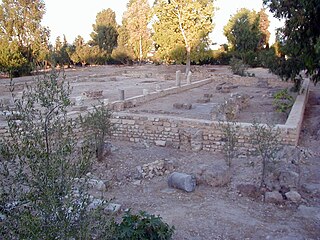
Thysdrus was a Carthaginian town and Roman colony near present-day El Djem, Tunisia. Under the Romans, it was the center of olive oil production in the provinces of Africa and Byzacena and was quite prosperous. The surviving amphitheater is a World Heritage Site.

Byzacena was a Late Roman province in the central part of Roman North Africa, which is now roughly Tunisia, split off from Africa Proconsularis.
The Councils of Carthage were church synods held during the 3rd, 4th, and 5th centuries in the city of Carthage in Africa. The most important of these are described below.

Maktar or Makthar, also known by other names during antiquity, is a town and archaeological site in Siliana Governorate, Tunisia.

Thuburbo Majus is a large Roman site in northern Tunisia. It is located roughly 60 km southwest of Carthage on a major African thoroughfare. This thoroughfare connects Carthage to the Sahara. Other towns along the way included Sbiba, Sufes, Sbeitla, and Sufetula. Parts of the old Roman road are in ruins, but others do remain.

Sbeitla or Sufetula is a small town in west-central Tunisia. Nearby are the Byzantine ruins of Sufetula, containing the best preserved Byzantine forum temples in Tunisia. It was the entry point of the Muslim conquest of North Africa.

The Catholic Church in Tunisia is part of the worldwide Catholic Church, under the spiritual leadership of the Pope in Rome.
The Primate of Africa is an honorific title in the Roman Catholic church, but in early Christianity was the leading bishop (primas) in Africa except for Mauretania which was under the bishop of Rome and Egypt which was suffragan to Alexandria.
Verecundus was a 6th-century writer and the bishop of Iunca in Roman North Africa. He was an ardent champion of the Three Chapters.

Thala is a town and commune in Tunisia. It is located in the Kasserine Governorate since 1956. As of the 2004 census it had 13,968 inhabitants. The altitude of Thala is 1,017 metres (3,337 ft), which makes it the highest and the coldest town in the country.

Almost all Roman roads in Africa were built in the first two centuries AD. In 14 AD, Legio III Augusta completed a road from Tacape to Ammaedara: the first Roman road in Africa. In 42 AD, the kingdom of Mauretania was annexed by Rome. Emperor Claudius then restored and widened a Carthaginian trail and extended it west and east. This way the Romans created a continuous coastal highway stretching for 2,100 miles from the Atlantic to the Nile. In 137, Hadrian built the Via Hadriana in the eastern desert of Egypt. It ran from Antinoopolis to Berenice.

Pupput, also spelled "Putput", "Pudput", "Pulpud" and "Pulpite" in Latin, sometimes located in Souk el-Obiod ou Souk el-Abiod, is a Colonia in the Roman province of Africa which has been equated with an archaeological site in modern Tunisia. It is situated on the coast near the town of Hammamet, between the two wadis of Temad to the north and Moussa to the south. Much of the Pupput is buried under modern holiday developments which have been built over the major part of the site.

The Archdiocese of Carthage, also known as the Church of Carthage, was a Latin Catholic diocese established in Carthage, Roman Empire, in the 2nd century. Agrippin was the first named bishop, around 230 AD. The temporal importance of the city of Carthage in the Roman Empire had previously been restored by Julius Caesar and Augustus. When Christianity became firmly established around the Roman province of Africa Proconsulare, Carthage became its natural ecclesiastical seat. Carthage subsequently exercised informal primacy as an archdiocese, being the most important center of Christianity in the whole of Roman Africa, corresponding to most of today's Mediterranean coast and inland of Northern Africa. As such, it enjoyed honorary title of patriarch as well as primate of Africa: Pope Leo I confirmed the primacy of the bishop of Carthage in 446: "Indeed, after the Roman Bishop, the leading Bishop and metropolitan for all Africa is the Bishop of Carthage."

Ounga, also known as Younga and Jounga, is an archaeological site on the Mediterranean coast of Tunisia, located 45 km (28 mi) south of Sfax along the Mediterranean coast. The area is also known for its oil fields.

The diocese of Puzia in Byzacena is a suppressed and titular seat of the Roman Catholic Church.

Garriana was a Roman town of the province of Byzacena during late antiquity. The town has tentatively been identified with the ruins at Henchir-El-Garra in modern Tunisia. The name Henchir-El-Garra simply means the Ruins of Garria.

Septimunicia is a titular bishopric of the Roman Catholic Church. The location is not certain, but assumed to be in Tunisia. Today Settimunicia survives as a titular bishopric and the current bishop is Emilio Bataclan, of Cebu.

Marazanae was a Roman town of the Roman province of Byzacena during the Roman Empire and into late antiquity.
The Diocese of Valentiniana was a Roman-Berber civitas located in the province of Byzacena. It was re-established in 1933 as a Roman Catholic titular see.
The Battle of Sufetula took place in either late 546 or early 547, at Sufetula in Byzacena, a province of Byzantine Empire, in what is now Tunisia during the Moorish uprisings against the Byzantines. It was fought by Byzantine forces led by John Troglita, against Moorish rebels led by Antalas. The battle resulted in a crushing Byzantine victory: the Berbers suffered heavy losses, and the battle-standards lost at the battle of Cillium in 544 were recovered by the Byzantines.












